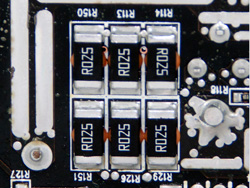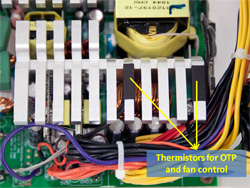A Detailed Look Into PSUs |
|
The Various Protections of a PSU
In this section we will make a reference to the various protections that a PSU has in order to avoid dramatic situations. Many budget PSUs have only the necessary protections that the ATX specification demands (OCP, SCP, OVP), but hi-end ones usually have much more.Power Good (PWR_OK)
As ATX specification states power good or PWR_OK signal is used by the PSU to indicate that the 5V, +3.3 V and +12V outputs are within the regulation thresholds of the power supply and that sufficient mains energy is stored by the converter to guarantee continuous power operation within specification for at least 16ms under full load. The PWR_OK according to ATX spec must be below 500 ms.
Over Current Protection (OCP)
An omni-present protection found in most PSUs. It kicks in when the current in the rails surpasses a limit. ATX 2.2 specification stated that if the load at each tested output rail reached or exceeded 240 VA then OCP should interfere (paragraph 3.4.4). However ATX 2.31 specification omitted the 240 VA limit. Many manufacturers, in order to bypass the 240 VA limit that the older ATX 2.2 specification had set, implemented many virtual +12V rails with each rail rated at 240 VA, however in most cases the OCP trigger point was set up much higher, in order to withstand peak currents.

To implement OCP in a PSU two things are necessary, a protections IC that supports OCP and shunt resistors. The latter are low resistance, high precision resistors used to measure the current at the outputs of a PSU, exploiting the voltage drops those currents create across them. By measuring the number of shunts in a PSU, in the area were +12V wires are soldered, we are able to find the real number of +12V virtual rails. In some cases, where the manufacturer built the PSU as multi +12V rail at first and then decided to convert it to single +12V rail, the shunt resistors are shorted together.
Over Voltage/Under Voltage Protection (OVP/UVP)
The ATX 2.31 specification states that the overvoltage protection sense circuitry and reference shall reside in packages that are separate and distinct from the regulator control circuitry and reference. So no single point fault shall be able to cause a sustained over voltage condition on any or all outputs. In other words all PSUs must have an independent protections circuit and not count solely on the PWM controller to monitor the output voltages. Here we must also add that UVP is optional since it's not mentioned in ATX specification!As you have already guessed OVP and UVP constantly check the voltages at each rail and kick in if these surpass a trigger point. The ATX 2.31 gives a table with the minimum, nominal and maximum values for the OVP trigger points. It includes the 5VSB rail although it states that OVP protection in this rail is recommended but not required! below you will find the relevant table.
| Output | Minimum (V) | Nominal (V) | Maximum (V) |
|---|---|---|---|
| +12 VDC (or 12V1DC & 12V2DC) | 13.40 V | 15.0 V | 15.6 V |
| +5 VDC | 5.74 V | 6.3 V | 7.0 V |
| +3.3 VDC | 3.76 V | 4.2 V | 4.3 V |
| 5VSB (optional) | 5.74 V | 6.3 V | 7.0 V |
Now as for the UVP trigger points, since they are not covered from the ATX specification each manufacturer of IC protection circuits is free to set his own.
Over Power Protection (OPP)
This protection kicks in when the power we pull from a PSU exceeds its maximum rated capacity. Usually the manufacturers give a little room for overpowering the PSU, so the OPP threshold is set 50-100 Watts (in some cases even more) above the maximum rated wattage of the PSU. In single +12V rail PSUs, where OCP practically is meaningless, OPP saves the day if something goes wrong.Over Temperature Protection (OTP)


When this protection is present we usually find a thermistor in the secondary heatsink (attention, the fan control unit very often uses a thermistor in the same heatsink). The thermistor informs the protections circuit about the temperature of the heatsink. If temperature exceeds a preset temperature point then the PSU is shut down. An excessive temperature maybe a result of overloading or cooling fan's failure so OTP prevents (further) damage to the PSU.
Short Circuit Protection (SCP)
This protection constantly monitors the output rails and if it finds an impedance of less than 0.1O then it immediately shuts down the power supply. In other words if somehow the output rails are short-circuited then this protection kicks in and shuts down the PSU, to prevent damage/fire. ATX 2.31 spec states that the two +12V rails should have separate short circuit.
Apr 8th, 2025 05:29 EDT
change timezone
Latest GPU Drivers
New Forum Posts
- is it worth using ssd with usb2? (13)
- Is RX 9070 VRAM temperature regular value or hotspot? (330)
- RX 9000 series GPU Owners Club (238)
- 5070 cards available below £550 in in the UK (76)
- 9070XT or 7900XT or 7900XTX (130)
- The easiest way to connect the BOOTSEL test metal terminal and the GND terminal.... (2)
- gpu heirarchy/performance/benchmarks- whos lying? (67)
- Sapphire NITRO+ RX 5700 XT BE original BIOS request (11)
- No idea how many watts this USB-C port will supply? (10)
- The coffee and tea drinkers club. (250)
Popular Reviews
- The Last Of Us Part 2 Performance Benchmark Review - 30 GPUs Compared
- UPERFECT UStation Delta Max Review - Two Screens In One
- PowerColor Radeon RX 9070 Hellhound Review
- ASUS Prime X870-P Wi-Fi Review
- Upcoming Hardware Launches 2025 (Updated Apr 2025)
- MCHOSE L7 Pro Review
- Sapphire Radeon RX 9070 XT Pulse Review
- Corsair RM750x Shift 750 W Review
- Sapphire Radeon RX 9070 XT Nitro+ Review - Beating NVIDIA
- DDR5 CUDIMM Explained & Benched - The New Memory Standard
Controversial News Posts
- NVIDIA GeForce RTX 5060 Ti 16 GB SKU Likely Launching at $499, According to Supply Chain Leak (161)
- MSI Doesn't Plan Radeon RX 9000 Series GPUs, Skips AMD RDNA 4 Generation Entirely (146)
- Microsoft Introduces Copilot for Gaming (124)
- AMD Radeon RX 9070 XT Reportedly Outperforms RTX 5080 Through Undervolting (119)
- NVIDIA Reportedly Prepares GeForce RTX 5060 and RTX 5060 Ti Unveil Tomorrow (115)
- Over 200,000 Sold Radeon RX 9070 and RX 9070 XT GPUs? AMD Says No Number was Given (100)
- NVIDIA GeForce RTX 5050, RTX 5060, and RTX 5060 Ti Specifications Leak (97)
- Nintendo Switch 2 Launches June 5 at $449.99 with New Hardware and Games (92)